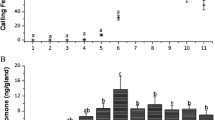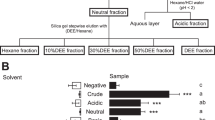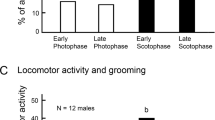Abstract
The aggregation behavior of the European earwigForficula auricularia was investigated. Bioassays of frass extracts, cuticular washings, and the defensive exudate have been conducted to locate the source of an aggregation pheromone, and aggregation behavior has been demonstrated with extracts of frass and the washings of male cuticular lipids. Chemical investigations revealed the presence of a unique pattern of typical normal, monomethyl-, and dimethylalkanes, along with a series of fatty acids and the well-known defensive quinones from these insects. It has been concluded from the bioassays of a number of authentic compounds and the lack of a chemically discernible difference between male and female extracts that the aggregation pheromone ofF. auricularia is quite probably a minor component of the male cuticular lipids.
Similar content being viewed by others
References
Antony, C., Davis, T.L., Carlson, D.A., Pechine, J.-M., andJallon, J.-M. 1985. Compared behavioral responses of maleDrosophila melanogaster (Canton S) to natural and synthetic aphrodisiacs.J. Chem. Ecol. 11:1617–1629.
Bagneres, A.G., andMorgan, E.D. 1990. A simple method for analysis of insect cuticular hydrocarbons.J. Chem. Ecol. 16:3263–3276.
Barnes, B.N., andCapatos, D. 1989. Evidence for an aggregation pheromone in adult frass of banded fruit weevil,Phylctinus callosus (Schoenherr) (Col., Curculionidae).J. Appl. Entomol. 108:512–518.
Blum, M.S. 1981. Chemical Defenses of Arthropods. Academic Press, New York.
Brousse-Gaury, P. 1983. Sur l'existence d'une glande tibiale chezLabidura riparia Pallas etForficula auricularia L. (Insectes, Dermapteres).C.R. Acad. Sci. Paris 297:203–208.
Brown, W.V., Jaisson, P., Taylor, R.W., andLacey, M.J. 1990. Novel internally branched, internal alkenes as major components of the cuticular hydrocarbons of the primitive Australian antNathomyrmicia macrops Clark (Hymenoptera: Formicidae).J. Chem. Ecol. 16:2623–2635.
Crumb, S.E.,Eide, P.M., andBonn, A.E. 1941. The European earwig. U.S.D.A. Technical Bulletin No. 766.
Fuchs, M.E.A., Francke, S., andFrancke, W. 1985. Carboxylic acids in the feces ofBlattella germanica (L.) and their possible role as part of the aggregation pheromone.Z. Angew. Entomol. 99:499–503.
Grunshaw, J.P., Guermouche, H., Guermouche, S., Jago, N.D., Jullien, R., Knowles, E., andPerez, F. 1990. Chemical taxonomic studies of cuticular hydrocarbons in locusts of theSchistocerca americana complex (Acrididae: Cyrtacanthacridinae): Chemical relationships between New World and Old World species.J. Chem. Ecol. 16:2835–2857.
Hamilton, W.D. 1971. Geometry for the selfish herd.J. Theor. Biol. 31:295–311.
Howard, D.F., Blum, M.S., Jones, T.H., andPhillips, D.W. 1982. Defensive adaptations of eggs and adults ofGastrophysa cyanea (Coleoptera: Chrysomelidae).J. Chem. Ecol. 8:453–462.
Howard, R.W., andBlomquist, G.J. 1982. Chemical ecology and biochemistry of insect hydrocarbons.Annu. Rev. Entomol. 27:149–172.
Ishii, S. 1970. Aggregation of the German cockroach,Blattella germanica (L.), pp. 93–109,in D. Wood, R. Silverstein, and M. Nakajima (eds.). Control of Insects by Natural Products. Academic Press, New York.
Lamb, R. 1975. Life history and population characteristics of the European earwig,Forficula auricularia (Dermaptera: Forficulidae), at Vancouver, British Columbia.Can. Entomol. 107:819–824.
Lockey, K.H. 1976. Cuticular hydrocarbons ofLocusta, Schistocerca, andPeriplaneta and their role in waterproofing.Insect Biochem. 6:457–472.
Lockey, K.H. 1988. Lipids of the insect cuticle: Origin, composition and function.Comp. Biochem. Physiol. 89B:595–645.
McFarlane, J., andAlli, I. 1985. Volatile fatty acids of frass of certain omnivorous insects.J.b Chem. Ecol. 11:59–63.
McFarlane, J., Steeves, E., andAlli, I. 1983. Aggregation of larvae of the house cricketAcheta domestica (L.) by propionic acid present in the excreta.J. Chem. Ecol. 9:1307–1315.
Nagel, M.G., andCade, W.H. 1983. On the role of pheromones in aggregation formation in camel crickets,Ceutophilus secretus (Orthoptera: Gryllacrididae).Can. J. Zool. 61:95–98.
Nault, L.R., andPhelan, P.L. 1984. Alarm pheromones and sociality in pre-social insects, pp. 237–256,in W.J. Bell and R.T. Cardé (eds.). Chemical Ecology of Insects. Chapman and Hall Ltd., New York.
NIST/EPA/MSDC. 1990. Mass Spectral Data Base, Version 3.0. National Institute of Standards and Technology, Gaithersburg, Maryland.
Ross, M.H., andTignor, K.R. 1986. Response of German cockroaches to a dispersant and other substances secreted by crowded adults and nymphs (Blattodea: Blattellidae).Proc. Entomol. Soc. Wash. 88:25–29.
Roth, L.M., andCohen, S. 1973. Aggregation in Blattaria.Ann. Entomol. Soc. Am. 66:1315–1323.
Sauphanor, B. 1992. Une phéromone d'agregation chezForficula auricularia.Entomol. Exp. Appl. 62:285–291.
Schaner, A.M., andJackson, L.L. 1992. (Z)-Heptadecen-2-one and other 2-ketones in the aggregation pheromone blend ofDrosophila martensis, D. buzzatii, andD. serido.J. Chem. Ecol. 18:53–63.
Schildknecht, H., andWeis, K. 1960. Zur Kenntnis des Pygidialdrusen-Sekretes vom gemeinen Ohrwurm,Forficula auricularia.Z. Naturforsch. 15b:755–757.
Sokal, R.R., andRohlf, F.J. 1981. Biometry: The Principles and Practice of Statistics in Biological Research. Freeman, New York.
Teale, S.A., Webster, F.X., Zhang, A., andLanier, G.N. 1991. Lanierone: A new pheromone component fromIps pini (Coleoptera: Scolytidae) in New York.J. Chem. Ecol. 17:1159–1175.
Tschinkel, W.R. 1972. 6-Alkyl-1,4-naphthoquinones from the defensive secretion of the tenebrionid beetle,Argoporis alutacea.J. Insect Physiol. 18:711–722.
Author information
Authors and Affiliations
Rights and permissions
About this article
Cite this article
Walker, K.A., Jones, T.H. & Fell, R.D. Pheromonal basis of aggregation in European earwig,Forficula auricularia L. (Dermaptera: Forficulidae). J Chem Ecol 19, 2029–2038 (1993). https://doi.org/10.1007/BF00983805
Received:
Accepted:
Issue Date:
DOI: https://doi.org/10.1007/BF00983805




